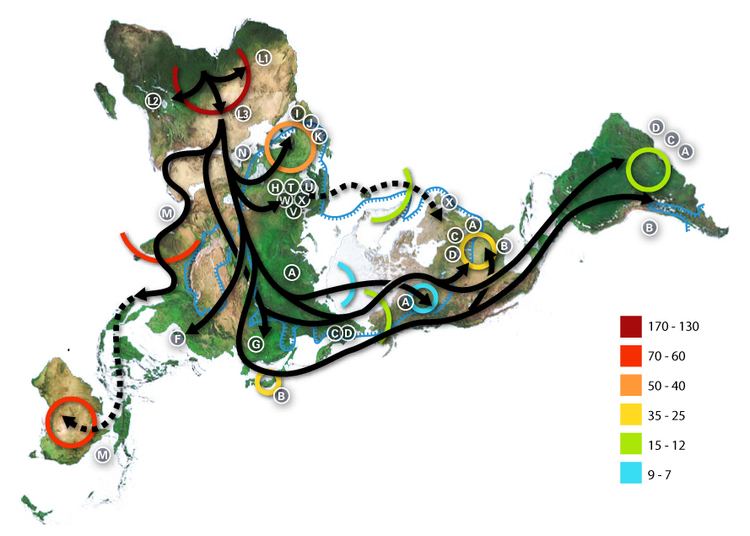Possible time of origin 23,900 YBP Ancestor CZ Defining mutations 489 10400 14783 15043 | Possible place of origin Central Asia Descendants C1, C4, C5, C7 | |
 | ||
In human mitochondrial genetics, Haplogroup C is a human mitochondrial DNA (mtDNA) haplogroup.
Contents
Origin
Haplogroup C is believed to have arisen somewhere between the Caspian Sea and Lake Baikal some 24,000 years before present. It is a descendant of the haplogroup M.
Distribution
Haplogroup C is found in Northeast Asia (including Siberia). In Eurasia, Haplogroup C is especially frequent among populations of arctic Siberia, such as Yukaghirs and Nganasans. Haplogroup C is one of five mtDNA haplogroups found in the indigenous peoples of the Americas, the others being A, B, D, and X. The subclades C1b, C1c, C1d, and C4c are found in the first people of the Americas. C1a is found only in Asia.
In 2010, Icelandic researchers discovered a C1 lineage in their home country, estimating an introduction date of 1700 or earlier, indicating a possible introduction during the Viking expeditions to the Americas. A Native American origin for this C1e lineage is likely, but the researchers note that a European or Asian one cannot be ruled out.
In 2014, a study discovered a new mdna subclade C1f from the remains of 3 people found in western Russia and dated to 7,500 years ago. It has not been detected in modern populations. The study proposed the hypothesis that the sister C1e and C1f subclades had split early from the most recent common ancestor of the C1 clade and had evolved independently. Subclade C1e had a northern European origin. Iceland was settled by the Vikings 1,130 years ago and they had raided heavily into western Russia, where the sister subclade C1f is now know to have resided. Both subclades were brought to Iceland through the Vikings, however C1e went extinct on mainland northern Europe due to population turnover and its small representation, and subclade C1f went extinct completely.
Tree
This phylogenetic tree of haplogroup C subclades is based on the paper by Mannis van Oven and Manfred Kayser Updated comprehensive phylogenetic tree of global human mitochondrial DNA variation and subsequent published research.
Popular culture
In his popular book The Seven Daughters of Eve, Bryan Sykes named the originator of this mtDNA haplogroup Chochmingwu.
